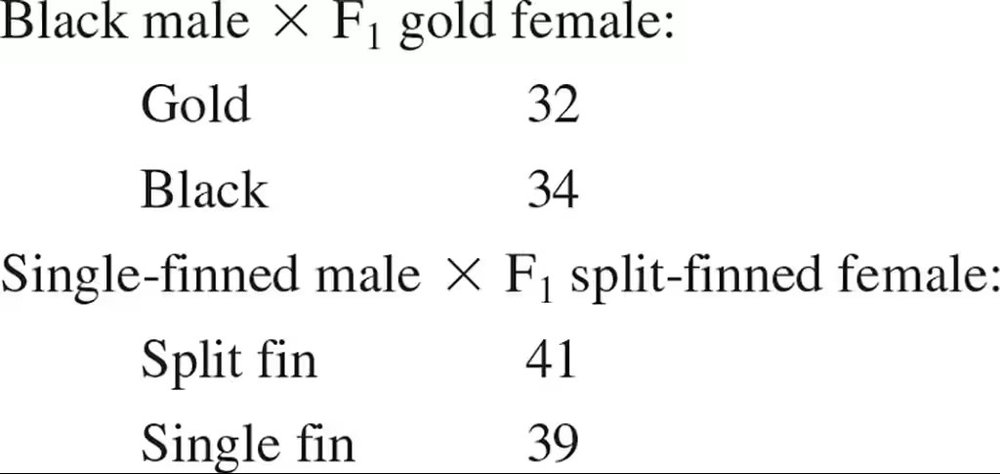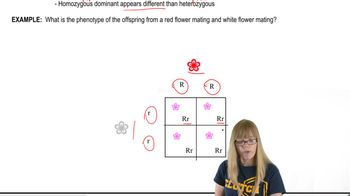Table of contents
- 1. Introduction to Genetics51m
- 2. Mendel's Laws of Inheritance3h 37m
- 3. Extensions to Mendelian Inheritance2h 41m
- 4. Genetic Mapping and Linkage2h 28m
- 5. Genetics of Bacteria and Viruses1h 21m
- 6. Chromosomal Variation1h 48m
- 7. DNA and Chromosome Structure56m
- 8. DNA Replication1h 10m
- 9. Mitosis and Meiosis1h 34m
- 10. Transcription1h 0m
- 11. Translation58m
- 12. Gene Regulation in Prokaryotes1h 19m
- 13. Gene Regulation in Eukaryotes44m
- 14. Genetic Control of Development44m
- 15. Genomes and Genomics1h 50m
- 16. Transposable Elements47m
- 17. Mutation, Repair, and Recombination1h 6m
- 18. Molecular Genetic Tools19m
- 19. Cancer Genetics29m
- 20. Quantitative Genetics1h 26m
- 21. Population Genetics50m
- 22. Evolutionary Genetics29m
2. Mendel's Laws of Inheritance
Mendel's Experiments and Laws
Problem 14b
Textbook Question
An experienced goldfish breeder receives two unusual male goldfish. One is black rather than gold, and the other has a single tail fin rather than a split tail fin. The breeder crosses the black male to a female that is gold. All the F₁ are gold. She also crosses the single-finned male to a female with a split tail fin. All the F₁ have a split tail fin. She then crosses the black male to F₁ gold females and, separately, crosses the single-finned male to F₁ split-finned females. The results of the crosses are shown below.

Is black color dominant or recessive? Explain. Is single tail dominant or recessive? Explain.
 Verified step by step guidance
Verified step by step guidance1
Step 1: Analyze the first cross (Black male x Gold female). All the F₁ offspring are gold. This suggests that the gold phenotype is dominant over the black phenotype. If black were dominant, we would expect at least some of the F₁ offspring to be black.
Step 2: Analyze the second cross (Single-finned male x Split-finned female). All the F₁ offspring have split fins. This suggests that the split fin phenotype is dominant over the single fin phenotype. If single fin were dominant, we would expect at least some of the F₁ offspring to have single fins.
Step 3: Examine the results of the second-generation cross (Black male x F₁ gold female). The offspring are approximately 50% gold and 50% black. This 1:1 ratio is consistent with a test cross where the F₁ gold female is heterozygous (Gg) and the black male is homozygous recessive (gg). This further supports that black is recessive.
Step 4: Examine the results of the second-generation cross (Single-finned male x F₁ split-finned female). The offspring are approximately 50% split fin and 50% single fin. This 1:1 ratio is consistent with a test cross where the F₁ split-finned female is heterozygous (Ss) and the single-finned male is homozygous recessive (ss). This further supports that single fin is recessive.
Step 5: Conclude that the black phenotype is recessive to gold, and the single fin phenotype is recessive to split fin. The observed ratios in the second-generation crosses align with Mendelian inheritance patterns for a single gene with two alleles, one dominant and one recessive.
 Verified video answer for a similar problem:
Verified video answer for a similar problem:This video solution was recommended by our tutors as helpful for the problem above
Video duration:
3mPlay a video:
Was this helpful?
Key Concepts
Here are the essential concepts you must grasp in order to answer the question correctly.
Dominance in Genetics
Dominance refers to the relationship between alleles, where one allele can mask the expression of another. In a dominant-recessive relationship, the dominant allele will determine the phenotype when present, while the recessive allele will only be expressed in a homozygous state. Understanding this concept is crucial for interpreting the results of genetic crosses, as it helps predict the phenotypic ratios of offspring based on parental genotypes.
Recommended video:
Guided course

Variations on Dominance
Phenotypic Ratios
Phenotypic ratios are the relative frequencies of different phenotypes in the offspring resulting from a genetic cross. By analyzing the offspring's traits, such as color and fin type in this case, one can infer the underlying genotypes of the parents. The observed ratios can indicate whether a trait is dominant or recessive, providing insights into the inheritance patterns of specific characteristics.
Recommended video:
Guided course

Mutations and Phenotypes
Monohybrid Cross
A monohybrid cross involves breeding individuals that differ in a single trait, allowing the study of inheritance patterns for that trait. In this scenario, the crosses between the black and gold goldfish, as well as the single-finned and split-finned goldfish, exemplify monohybrid crosses. Analyzing the offspring from these crosses helps determine the dominance of traits, as the resulting phenotypic ratios can reveal whether the traits are inherited in a dominant or recessive manner.
Recommended video:
Guided course

Monohybrid Cross
Related Videos
Related Practice
Textbook Question
What advantages were provided by Mendel's choice of the garden pea in his experiments?
594
views


